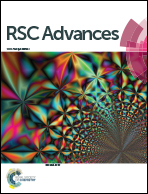A superhydrophilic and underwater superoleophobic chitosan–TiO2 composite membrane for fast oil-in-water emulsion separation†
Abstract
Oil/water separation has become a worldwide challenge due to large volumes of industrial oily wastewater and frequent oil spill accidents, which constitute an enormous threat to human and biological safety. Herein, a superhydrophilic and underwater superoleophobic composite membrane was fabricated using the vacuum-assisted filtration technique of assembly of chitosan (CS) and titanium dioxide (TiO2) on a cellulose acetate membrane for emulsified oil separation. The hydrophilic chitosan–TiO2 (CST) composite and nanoscale hierarchical structure are beneficial for forming a water layer that can repel the infiltration of oil droplets into the membrane. The modified membrane demonstrated an excellent flux up to 6002.5 L m−2 h−1 for hexadecane-in-water emulsion, which is one order of magnitude higher than traditional filtration membranes. Furthermore, the separation efficiency for all of the emulsified oils is above 97%, indicating superior oil/water separation performance. Most importantly, the modified membrane can maintain underwater superoleophobicity even in corrosive aqueous media, including strongly acidic, strongly alkaline, and highly saline solutions. It is expected that the chitosan–TiO2 composite membrane can be potentially useful in treating oily wastewater from industry and daily life.



 Please wait while we load your content...
Please wait while we load your content...